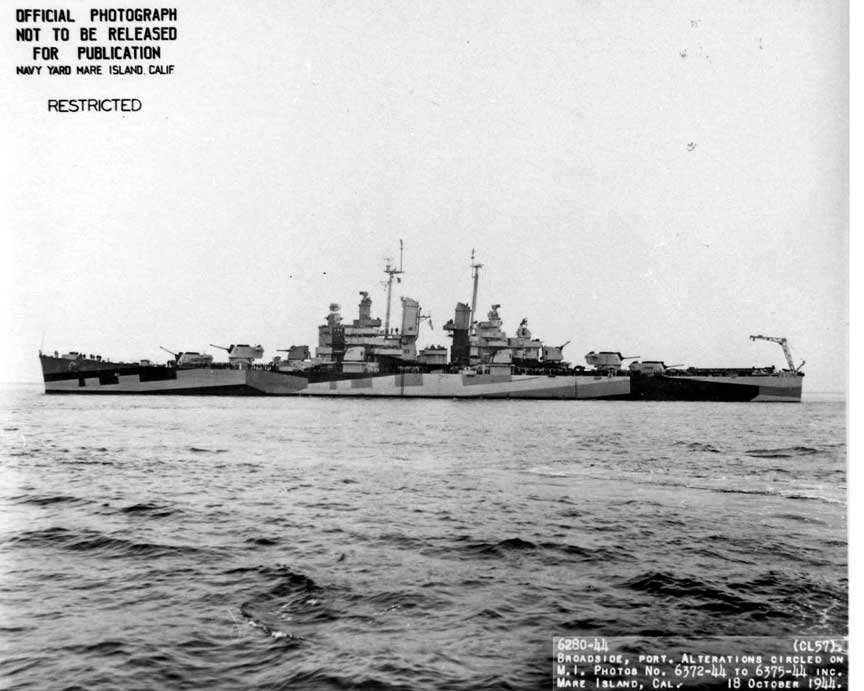USS Montpelier
The capital of Vermont.

II
(CL‑57: dp. 10,000; l. 608'4"; b. 66'; dr. 20'; s. 33 k.; cpl. 992; a. 12 6", 12 5", 28 40mm., 10 20mm. cl. Cleveland)
The second Montpelier (CL‑57) was laid down 2 December 1940 by New York Shipbuilding Corp., Camden, N.J.; launched 12 February 1942; sponsored by Mrs. William F. Carry; and commissioned 9 September 1942, Capt. Leighton Wood in command.
Montpelier arrived Noumea, New Caledonia, 18 January 1943 from Norfolk, Va. Rear Adm. A. S. Merrill chose her for the flagship of CruDiv 12. On 25 January, she reached Efate, New Herbrides, her home base for the next few months. While making a sweep around beleaguered Guadalcanal, she participated in the Battle of Rennell Island 29 January, the last naval engagement of the Guadalcanal campaign.
Montpelier covered the landings on the Russell Islands on 21 February. On the night of 5 to 6 March, she heavily bombarded the Vila‑Stanmore airfield on Kolombangara in the Solomons, and helped sink an enemy destroyer. She and three other cruisers bombarded Poporang Island on the night of 29‑30 June, in preparation for the invasion of New Georgia. On the night of 11‑12 July, she bombarded Munda, enabling troops to continue their conquest of New Georgia. She patrolled the New Georgia area for the next 4 months to prevent Japanese troop withdrawals.
After a run to Sydney, Australia, she joined TF 39 as its flagship for the invasion of the Treasury Islands and Bougainville. On 1 November Montpelier shelled the Buka‑Bonis airfields on the northern tip of Bougainville, and hit the Japanese defenses on Poporang and Ballale Islands, TF 39, consisting of cruisers and destroyers, engaged a superior Japanese force in the Battle of Empress Augusta Bay while guarding transports on the night of 2 November. The result was a clear cut victory for the U.S. ships commanded by Admiral Merrill. The victory turned back the Japanese from what would have been a disasterous assault on the Bougainville landing forces. Besides assisting in the destruction of one ship, Montpelier gunners shot down five enemy planes.
Between 15 and 19 February 1944, Montpelier covered the amphibious landing on Green in the Bismarcks. In March she hunted shipping south of Truk and participated in the invasion of the Emiraus, and began shelling Saipan 14 June to support the Marianas invasion. She joined TF 58 and participated in the decisive Battle of the Philippine Sea from 19 to 21 June. During the engagement, Japanese carrier air groups were virtually annihilated. Montpelier returned to the Marianas, and continued her shelling of Saipan, Tinian, and Guam. She left the Marianas 2 August for overhauling in the United States.
Returning 25 November, she joined a task group off Leyte Gulf. While steaming on defensive patrol off the gulf, she fought oft numerous kamikaze attacks, shooting down four planes. Beginning 12 December, Montpelier provided beach cover for the invasion of Mindoro. Fighting enemy suicide planes, she protected troops at the Lingayen Gulf landing in January 1945. In February she supported operations off Mariveles Harbor, Corregidor, and Palawan; and from 14 April to 23 April, she covered the landings on Mindanao. From her base at Subic Bay she steamed to Brunei Bay, Borneo, arriving 9 June. Between 17 June and 2 July, she sailed off the oil center at Balikpapen, providing support for minesweepers, underwater demolition teams, and amphibious forces. Australian troops were extremely grateful for the devastating shelling of enemy positions, which saved many Allied lives. During the latter part of July and early August, Montpelier made three antishipping sweeps in the East China Sea.
When hostilities ended, she anchored off Wakayama, Japan, and helped speed up the evacuation of Allied prisoners. After an inspection of Japanese ships, part of her crew went ashore to view the ruins of Hiroshima, ultimate reminder of the price of aggression. On 18 October she covered the landing of occupation forces at Matsuyama. Montpelier departed from Hiro Wan and Japanese waters 15 November for the east coast, having fought the enemy from their deepest point of advance to their very homeland.
She reported for duty with the Atlantic Fleet 11 December and 1 July 1946 reported for duty with the 16th Fleet. Montpelier decommissioned and berthed in reserve at Philadelphia 24 January 1947. She was struck from the Naval Register 1 March 1959, and was sold for scrap to Bethlehem Steel Co. 22 January 1960.
Montpelier received 13 battle stars for World War II service.
 >
>